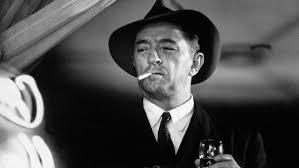Pick a Genre and Run With It
(Tune in to Writing Wednesdays this Monday, Wednesday, and Friday for the continuation of the series “Using Your Real Life in Fiction” — and for more of The Knowledge‘s backstory.)

Robert Mitchum as Philip Marlowe in “Farewell, My Lovely.”
The problem with real life is it’s messy. It doesn’t fit into neat categories.
But if you and I are going to use our real lives as material for fiction, we have to do just that.
We have to wrangle it.
We have to bring it under control.
We have to pick a story category, i.e. a genre, and make our real-life narrative work within that genre.
Or put another way, we have to ask ourselves, “If this mess in our real life were a publishable, ready-for-prime-time story, what genre would that story be?”
Is our real-life tale a Love Story? That’s a genre.
Is it a Thriller? That’s another genre.
A Western?
A Coming Of Age saga?
Shawn was the one who put his finger on what The Knowledge was. He nailed it the instant I showed him the first draft. (That’s how editors are trained to think.)
It’s a private eye story. It’s The Big Lebowski. It’s a detective story where the detective is not a hard-boiled private eye but a screwed-up young writer.
I can’t tell you how much that helped me.
Why? Because every story falls into a genre and every genre has conventions [see Chapter 41 in Nobody Wants To Read Your Sh*t].
A convention is an obligatory scene. It’s a story-beat that MUST be in the narrative if it’s going to fit into the genre.
Here’s how this helped me in working out the story for The Knowledge. I thought:
Hmm. If The Knowledge is a private eye story, then I have to have at least one scene where the private eye (i.e. Stretch, the character-that’s-me) gets beaten up.
Why? Because a Private-Eye-Gets-Beaten-Up scene occurs in every Sam Spade story, every Philip Marlowe story; it happens to Jake Gittes in Chinatown; it happens to the Dude in The Big Lebowski.
I literally sat down and wrote myself this note:
Come up with beat-up scene.
What other conventions does a private eye story mandate?
If the private eye gets hired by a woman, he must become romantically involved with that woman.
Note to self:
Come up with Romantic Involvement story.
In every private eye tale, the detective gets offered a second assignment (“Find so-and-so”), usually by the person that he was hired to find in the first place.
Further note:
Come up with this one too.
If you’re following along in The Knowledge, #1 is Chapter 15, “Glen Island Casino.” #2 is Chapter 28, “University Village.” And #3 are Chapter 18, “Empire Diner.”
Does this sound like formula?
It’s not.
This is how a writer thinks.
This is how a writer works.
This is how a writer structures and shapes a story.
Remember that our Most Dreaded Outcome in attempting a story based on our real life is that the tale will be too ego-centered, too ordinary, too internal, too boring.
Our aim as writers is to
1) Heighten the drama
2) Make the internal external
3) Give the story meaning, i.e. THEME.
4) Make it universal
5) Make it beautiful
When we pick a genre and work within its conventions, we automatically accomplish all five points above (assuming we do a good job with the story).
But even better, we acquire a road map and a structure that are invaluable to us as we’re working out the fictional, and even the real-life, aspects of our tale.
Genre is not a four-letter word.
It’s our secret weapon for real-life-based fiction, and for every other kind as well.



